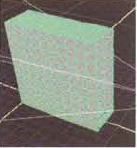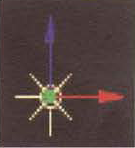Chapter 11. Working with 2.5D and 3D
"I almost always work in 2.5D, even when I'm not working with [render] passes from a 3D program."

2D compositing is limited by its lack of depth. That is, the virtual camera can move in the X or Y direction but not along the z-axis. You can add the third dimension, however, by creating a 3D camera. In that case, 2D layers and outputs may be arranged in 3D space. This combination of 2D and 3D is often referred to as 2∼HFD or 2.5D. Both After Effects and Nuke support 2.5D workflows by making 3D cameras, lights, and materials available. Nuke goes so far as to add a complete set of shaders and geometry manipulation tools. With this chapter, you'll have the chance to set up a 2.5D environment complete with cameras, lights, materials, and texture projections.

2D vs. 2.5D vs. 3D
By default, compositing programs operate in a 2D world. Layers and outputs of nodes are limited to two dimensions: X and Y. The ability of one layer or output to occlude another is based upon the transparency information of its alpha channel.
Compositing programs offer the ability to add the third dimension, Z, by creating or adding a 3D camera. The layers or outputs remain 2D, but they are viewable in 3D space. When a 2D image is applied ...
Get Professional Digital Compositing: Essential Tools and Techniques now with the O’Reilly learning platform.
O’Reilly members experience books, live events, courses curated by job role, and more from O’Reilly and nearly 200 top publishers.

